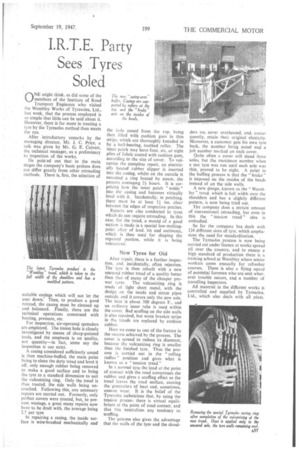I.R.T.E, Party
Page 47

If you've noticed an error in this article please click here to report it so we can fix it.
Sees Tyres Soled
ONE might think, as did some of the members of the Institute of Road Transport Engineers who visited the Wembley Works of Tyresoles, Ltd., last week, that the process employed is so simple that little can be said about it. However, there is far more in treating a tyre by the Tyresoles method than meets the eye.
After introductory remarks by the managing director, Mr. J. C. Price, a talk was given by Mr. G. E. Calvert, the technical manager, as a preliminary to inspection of the works.
Ile pointed out that in the main stages the company's basic pro'cess does not differ greatly from other retreading methods. There is, first, the selection of suitable casings which will not let the user down.' Then, to produce a good retread, the casing must be cleaned up and balanced. Finally, there are the technical operations concerned with heating, pressure, etc.
For inspection, air-operated spreaders are employed. The tiniest hole is closely investigated by means of sharp-pointed tools, and the emphasis is on quality, not quantity—in fact, some say the inspection is too strict.
A casing considered sufficiently sound is then machine-buffed, the main point being to clean the dirty tread and level it off, only enough rubber being removed to make a good surface and to bring the tyre to a standard dimension to suit the vulcanizing sing. Only the tread is thus treated, the side walls being untouched. Following this, any necessary repairs are carried out. Formerly, only perfect covers were treated, but, to prevent wastage, a great many repairs now have to be dealt with, the average being 2.7 per tyre.
In repairing a casing, the inside surface is wire-brushed mechanically and
the hole coned from the top, being then filled with cushion gum in thin strips, which are thoroughly kneaded in by a ball-bearing, toothed roller. The inner patch may have four, six, or eight plies of fabric coated with cushion gum, according to the size of cover. To vulcanize the complete repair, an electrically heated rubber slipper is inserted into the casing, whilst on the outside is mounted a ring heated by steam, the process averaging 2i hours. It is surprising how the inner patch " welds " into the casing and becomes virtually level with it. Incidentally, in patching, there must be at least I ins, clear between the edges of respective patches.
Repairs are also conducted to tyres which do not tequire retreading. In this case, for the tread, a mould of a good section is made in a special low-meltingpoint alloy of lead, tin and antimony, which is then used for shaping the repaired portion, while it is being vulcanised.
New Tyres for Old
After repair, there is a further inspection, and, incidentally, often rejection. The tyre is then rebuilt with a new uncured rubber tread of a quality better than that of many of the cheaper pre
war tyres. The vulcanizing ring is made of light sheet metal, with the design on the inside and steam pipes outside, and it covers only the new sole. The heat is about 300 degrees F., and an ordinary inner tube is used within the cover. Bad scuffing on the side walls is also repaired, but worn breaker strips in the treads are replaced by cushion rubber.
Here we come to one of the factors in the success achieved by the process. The cover is spread to reduce its diameter, because the vulcanizing ring is smaller than the finished tyre. Thus the process is carried out in the "rolling radius" position and gives what is known as a "tension tread."
In a normal tyre the load at the point of contact with the road compresses the rubber and gives a scuffing effect as the tread leaves the road surface, causing the gcneratiol Of heat and, sometimes, uneven wear. It is the belief of the Tyresoles technicians that, by using the tension process there is virtual equilibrium at the point of road contact, and that this neutralizes any tendency to scuffing.
The process also gives the advantage that the walls of the tyre and the shoul
ders are never overheated, and, consequently, retain their original elasticity. Moreover, a customer gets his own tyre back, the number being noted and a job number marked on each cover.
Quite often a cover will stand three soles, but the maximum number when a test tyre was run until each sole was thin, proved to be eight. A point in the buffing process is that the " brake " is imposed on the insides of the beads instead of on the side walls.
A new design, known as the " Wembley " tread, which is full width over the shoulders and has a slightly different pattern, is now being tried out.
The company does a certain amount of conventional retreading, but even in this the "tension tread" idea is embodied.
So far the company has dealt with 124 different sizes of tyre, which emphasizes the need for standardization.
The Tyresoles process is now being carried out under licence at works spread all over the country, and to ensure a high standard of production there is a training school at Wembley where senior workers come annually for refresher courses. There is also a flying squad of potential foremen who are sent wherever trouble occurs, and a number of travelling inspectors.
All material in the different works is controlled and supplied by Tyresoles. Ltd., which also deals with all plant.












































































